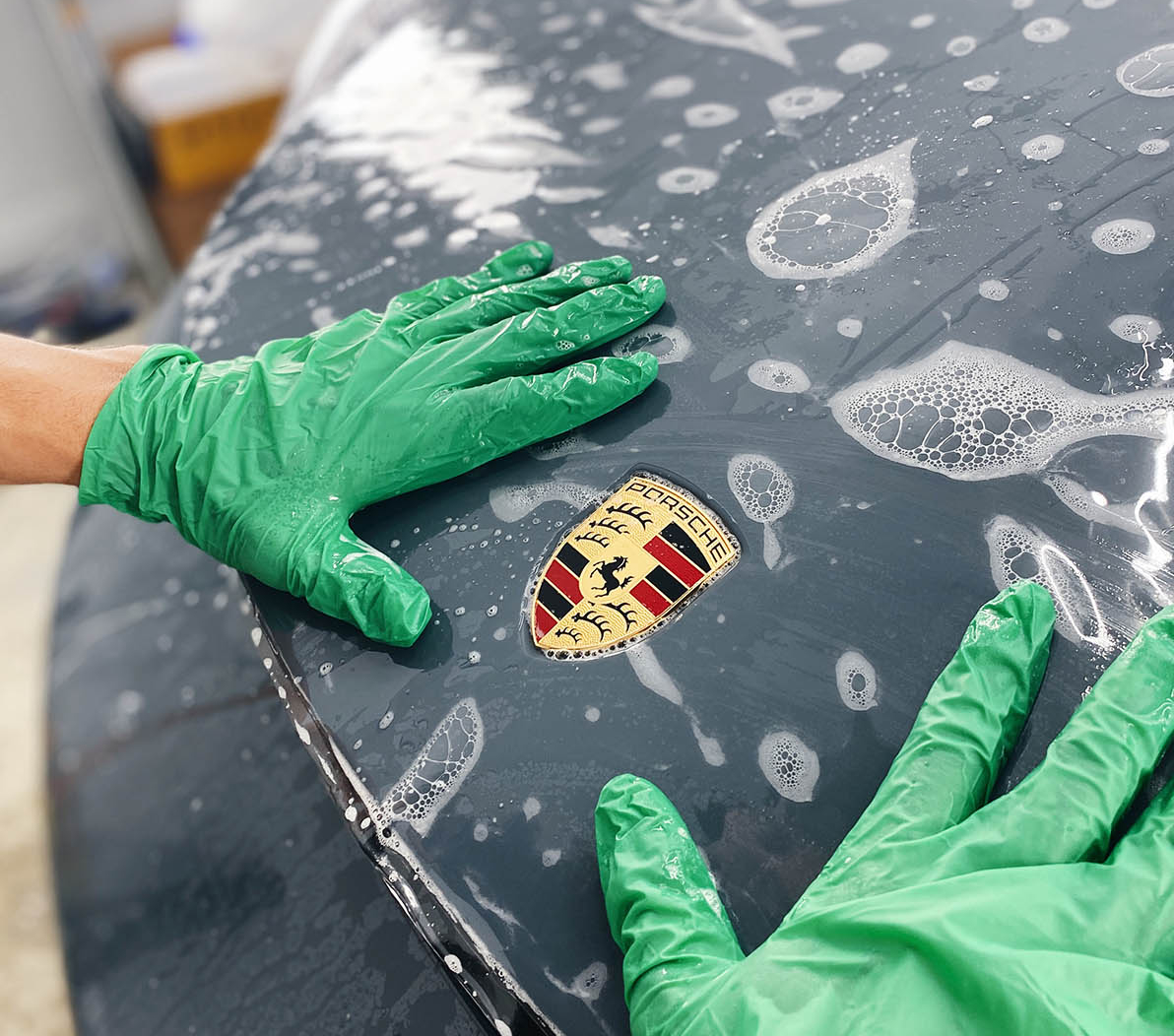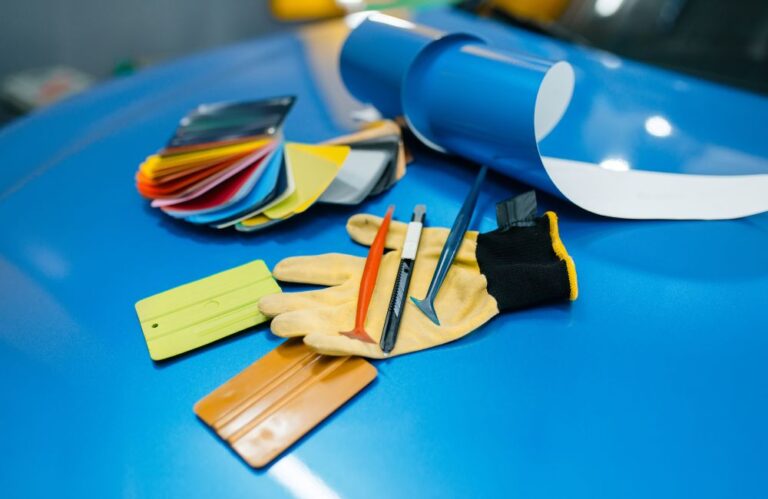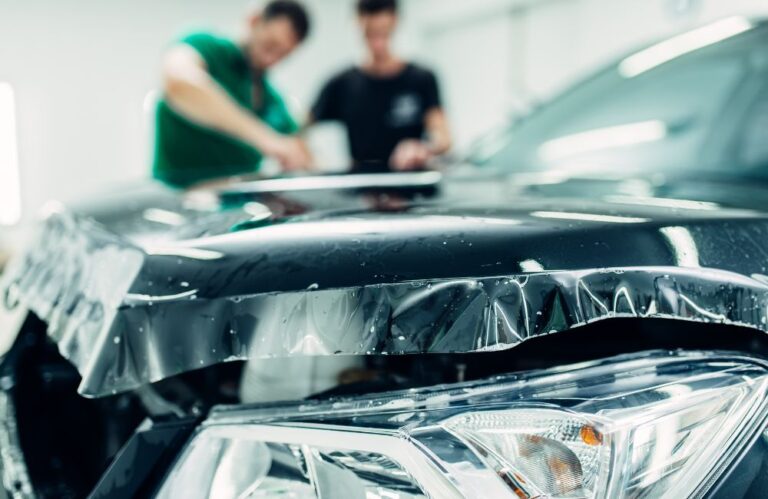When it comes to giving your car a fresh look or protecting its paint from the elements, vinyl wraps have gained tremendous popularity among car enthusiasts. They offer a unique and customizable appearance, making your vehicle stand out. However, as with any car modification, concerns and questions arise.
Are wraps bad for your car? Let’s find out!
What is a Vinyl Wrap?

A vinyl wrap is a high-quality adhesive film that is applied to the exterior of a vehicle, essentially serving as a protective and decorative skin.
Vinyl wraps come in a wide range of colors, textures, and finishes, providing car owners with almost limitless possibilities for customizing their vehicles. Whether you want a matte black finish, a glossy metallic look, or even a custom graphic design, vinyl wraps can achieve these effects with precision and detail.
The key components of a vinyl wrap include:
Vinyl Material: The primary material used in vinyl wraps is, of course, vinyl. This material is highly flexible and can be stretched and molded to fit the contours of a vehicle’s body.
- Adhesive Backing: The vinyl material is backed by an adhesive layer that ensures it adheres securely to the car’s surface.
- Release Liner: The adhesive side of the vinyl is protected by a release liner, which is removed during the installation process.
- Air Release Technology: Many modern vinyl wraps incorporate air release technology, which allows for the easy elimination of air bubbles during installation, ensuring a smooth and seamless finish.
- Laminate Layer (Optional): Some vinyl wraps also include a clear laminate layer that adds an extra level of protection and can enhance the vinyl’s appearance, such as giving it a glossy finish.
How Vinyl Wraps Are Applied
The process of applying a vinyl wrap to a vehicle’s surface is a meticulous and skill-dependent task that is typically best left to professionals. However, understanding how it’s done can provide insight into the care and precision required for a successful vinyl wrap installation.
- Surface Preparation: Before any vinyl is applied, the vehicle’s surface must be thoroughly cleaned and prepared. This includes washing, degreasing, and sometimes even polishing the paint to ensure it is in the best possible condition. Any imperfections or contaminants on the surface can negatively affect the adhesion of the vinyl and the final appearance of the wrap.
- Measurement and Cutting: Next, the vinyl wrap is carefully measured and cut to the exact dimensions of the vehicle’s panels. Precision in this step is crucial to achieving a seamless look.
- Vinyl Application: The vinyl wrap, with its adhesive side exposed, is then carefully applied to the vehicle’s surface. Professionals often use specialized tools, such as squeegees, heat guns, and cutting blades, to ensure a precise fit and to eliminate air bubbles and wrinkles.
- Stretching and Conforming: Vinyl is highly flexible, allowing it to be stretched and conformed to the curves and contours of the vehicle’s body. This is where the skill of the installer truly shines, as they must ensure that the vinyl conforms smoothly without excessive stretching, which can cause distortion.
- Trimming and Detailing: Once the vinyl is in place, excess material is trimmed away, and any seams or overlaps are meticulously addressed. The edges of the vinyl are often wrapped around the edges of the panels for a clean finish.
- Heat Treatment: In some cases, heat may be applied to the vinyl after installation to help it conform more snugly and activate the adhesive, ensuring a secure bond to the car’s surface.
- Quality Check: A thorough quality check is performed to inspect for any imperfections, bubbles, or areas where the vinyl may not be adhering correctly. Any issues are corrected before the job is considered complete.
- Optional Lamination: If a clear laminate layer is part of the wrap, it is applied over the vinyl to provide additional protection and enhance the appearance. This lamination step requires careful attention to detail to prevent air bubbles or imperfections.
- Post-Installation Inspection: After the vinyl wrap is applied and any optional lamination is completed, a final inspection is performed to ensure that the entire installation is flawless. This includes scrutinizing the seams, edges, and overall appearance of the wrap.
- Curing Period: Depending on the type of vinyl and environmental conditions, a curing period may be necessary to allow the adhesive to fully bond with the car’s surface. During this time, it’s important to avoid exposing the vehicle to extreme conditions or washing it.
The expertise required for a successful vinyl wrap installation cannot be understated. Professional installers undergo extensive training and have the experience needed to achieve a flawless finish while minimizing the risk of damage to the vehicle’s paint. For those considering a vinyl wrap, choosing a reputable installer is a critical step in ensuring a positive outcome.
Why Surface Condition Matters With Vinyl Wrap
Before we answer the question “does vinyl wrap damage paint? ”Let’s look into one important factor first. When considering the impact of a vinyl wrap on your car’s paint, it’s essential to recognize the pivotal role that the surface condition of your vehicle plays in the overall outcome. The state of your car’s paint before applying the vinyl wrap can significantly affect the final result and potential risks.
Paint Quality Before Applying the Vinyl Wrap
The condition of your car’s original paint is a crucial factor to consider. If the paint is in excellent shape, free from significant imperfections, and has been properly maintained, it sets the stage for a successful vinyl wrap application. A well-maintained paint surface provides a smoother canvas for the vinyl to adhere to, ensuring a more even and secure bond.
Conversely, if your car’s paint is already compromised with deep scratches, chips, or oxidation, these issues may become more noticeable after the vinyl wrap is applied. While vinyl wraps can provide a protective layer, they won’t magically repair existing paint damage. In fact, a vinyl wrap can accentuate imperfections, making them more visible under the vinyl.
Assessing Potential Paint Damage
Before deciding to install a vinyl wrap, it’s advisable to have a professional assess the condition of your car’s paint. They can identify any areas that may require correction or repair before proceeding with the vinyl wrap installation. Addressing these issues in advance will help ensure a smoother, more aesthetically pleasing result.
It’s important to remember that vinyl wraps are not a solution for severely damaged or deteriorating paint. In such cases, it may be more prudent to invest in paint restoration or refinishing before considering a vinyl wrap in Hackensack, NJ.
Common Myths and Misconceptions With Vinyl Wraps
Despite the growing popularity of vinyl wraps, several myths and misconceptions persist regarding their impact on a car’s paint. Let’s debunk some of these myths and provide a clearer understanding of the actual effects of vinyl wraps on your vehicle’s finish.
1.Myth: Vinyl Wraps Suffocate the Paint
Does wrapping your car damage the paint? Well, one common misconception is that vinyl wraps “suffocate” the underlying paint by sealing it off from the environment. In reality, vinyl wraps are not airtight and do not completely seal the paint beneath. They are porous to some extent, allowing for some degree of airflow.
The adhesives used in vinyl wraps are designed to be breathable, which means that they permit air and moisture to pass through. This design prevents moisture from becoming trapped between the vinyl and the paint, reducing the risk of corrosion. However, this breathability is not a substitute for proper surface preparation and corrosion prevention measures.
2. Myth: Vinyl Wraps Cause Uneven Fading
Another misconception is that vinyl wraps can lead to uneven fading of the underlying paint. The belief is that areas covered by the wrap may fade differently from the exposed areas.
Is vinyl wrap bad for your car? In reality, vinyl wraps are designed to shield the underlying paint from harmful UV rays, which are a primary cause of paint fading. Therefore, a well-maintained vinyl wrap can actually help preserve the original paint’s color and finish by acting as a barrier against UV damage. However, the effectiveness of UV protection can vary depending on the quality of the vinyl used and the diligence of the installer.
3. Myth: Vinyl Wraps Cause Paint to Peel or Lift
Do wraps damage paint? Some people worry that applying a vinyl wrap to their car will cause the paint to peel or lift when the wrap is eventually removed. This concern is valid to some extent, as poor-quality wraps or incorrect installation techniques can lead to adhesion issues.
However, when applied correctly by a professional installer, vinyl wraps should not cause the underlying paint to peel or lift. In fact, they should protect the paint during their lifespan. The key is to choose a reputable installer who uses high-quality materials and follows proper installation procedures.
4. Myth: Vinyl Wraps Are Irreversible and Permanent
A significant advantage of vinyl wraps is that they are not permanent. You can choose to remove the wrap at any time without causing damage to your car’s original paint. Some people mistakenly believe that once a vinyl wrap is applied, it can never be taken off.
In reality, professional vinyl wrap removal is a carefully executed process. When done correctly, it leaves the paint underneath in excellent condition, often protected from the elements and potential minor damage that may have occurred during the wrap’s lifespan.
5. Myth: Vinyl Wraps Are Indestructible
While vinyl wraps are durable and offer protection to a certain extent, they are not indestructible. They can still be scratched, punctured, or damaged by impacts. Therefore, it’s essential to exercise caution and avoid abrasive materials or harsh cleaning techniques that can damage the wrap.
Additionally, the longevity of a vinyl wrap depends on various factors, including the quality of the vinyl, the skill of the installer, and how well it’s maintained. Over time, vinyl wraps can show signs of wear and may need to be replaced or removed.
When applied correctly to a well-maintained vehicle, vinyl wraps can enhance the appearance and protect the original paint, providing a versatile and reversible option for car customization. However, it’s crucial to approach vinyl wrap installation with proper knowledge, realistic expectations, and the assistance of professionals to achieve the best results while safeguarding your car’s finish.
How to Minimize the Risk of Paint Damage

Vinyl wraps offer a versatile and creative means of transforming your car’s appearance, all while providing a layer of protection for the original paint. However, to truly reap the benefits of a vinyl wrap in Hackensack, NJ, and ensure that your car’s paint remains in pristine condition, it’s essential to understand how to minimize the risk of paint damage during and after installation.
1. Choosing a Reputable Vinyl Wrap Installer
One of the most critical factors in minimizing the risk of paint damage when getting a vinyl wrap for your car is selecting a reputable and experienced vinyl wrap installer. The competence and professionalism of the installer significantly influence the overall outcome of the installation. Here’s how to make an informed choice:
- Research and Reviews: Start by conducting thorough research online. Look for local vinyl wrap installers or shops that specialize in vehicle customization. Reading reviews and testimonials from previous customers can provide valuable insights into the quality of their work and customer satisfaction.
- Certification and Experience: Check if the installer is certified by reputable vinyl wrap manufacturers or industry organizations. Certification is often an indication of their commitment to high standards and ongoing training. Moreover, inquire about their experience and portfolio. A well-established installer with a track record of successful projects is more likely to deliver quality results.
- Ask for References: Don’t hesitate to ask the installer for references or examples of their previous work. Viewing their portfolio and speaking with past clients can give you a better understanding of their capabilities and the quality of their craftsmanship.
- Visit the Facility: If possible, visit the installer’s facility in person. A clean, organized, and well-equipped workspace is a positive sign. It reflects their professionalism and commitment to delivering top-notch results.
- Get Multiple Quotes: To ensure you are getting a fair price and quality service, obtain quotes from multiple installers. Be cautious of significantly lower prices, as they may indicate inferior materials or workmanship. A balance between affordability and quality is key.
- Communication: Open and clear communication with the installer is crucial. Discuss your expectations, design preferences, and any concerns you may have. A reputable installer should be willing to address your questions and provide guidance based on their expertise.
2. Proper Surface Preparation
Another critical aspect of minimizing the risk of paint damage when applying a vinyl wrap is ensuring that the vehicle’s surface is properly prepared before installation. Proper surface preparation sets the foundation for a successful vinyl wrap application:
- Cleaning and Decontamination: Before the vinyl wrap is applied, the car’s surface must be meticulously cleaned to remove dirt, grime, wax, and other contaminants. Any residue left on the surface can interfere with the vinyl’s adhesion and lead to issues down the line.
- Paint Correction if Necessary: If the original paint has imperfections like swirl marks, scratches, or oxidation, consider addressing these issues before applying the vinyl wrap. Paint correction involves a series of steps, including compounding, polishing, and sealing, to restore the paint’s smooth and glossy finish. This step not only enhances the final appearance but also ensures a better bond between the vinyl and the paint.
- Dealing with Rust and Corrosion: If your vehicle has areas with rust or corrosion, it’s crucial to address these issues before applying the vinyl wrap. Ignoring rust can lead to further damage and compromise the wrap’s integrity. Professional rust repair and prevention measures should be taken to safeguard your vehicle.
- Surface Evaluation: A professional installer will thoroughly inspect the car’s surface to identify any potential issues that need attention. They will assess the condition of the paint, look for dents or dings, and ensure that the surface is smooth and free from imperfections that could affect the wrap.
- Adhesion Promoters and Primers: In some cases, adhesion promoters or primers may be used to enhance the bond between the vinyl and the paint. These products are applied sparingly and strategically, following manufacturer guidelines.
3. Quality Materials and Maintenance

Beyond the selection of a reputable installer and proper surface preparation, the quality of materials used and ongoing maintenance play significant roles in protecting your car’s paint when applying a vinyl wrap in Hackensack, NJ:
- Select Premium Vinyl Material: Choose high-quality vinyl materials from reputable manufacturers. Premium vinyl offers better durability, color retention, and resistance to UV rays. While it may come at a slightly higher cost, it ensures a longer-lasting and better-looking wrap.
- Follow Manufacturer Recommendations: Ensure that the vinyl wrap installer follows the manufacturer’s guidelines and recommendations for installation. These guidelines often specify the optimal conditions and techniques for applying the vinyl, ensuring a secure and long-lasting bond.
- Regular Cleaning and Maintenance: Once the vinyl wrap is installed, regular cleaning and maintenance are essential to preserve its appearance and protect the underlying paint. Use manufacturer-recommended cleaning products and techniques to prevent damage to the wrap. Avoid abrasive materials or harsh chemicals that can cause premature wear.
- Prompt Attention to Damage: If your vinyl wrap sustains any damage, such as scratches or tears, address it promptly. Ignoring small issues can lead to more extensive damage over time. Professional installers can often repair minor damage, preserving the integrity of the wrap and protecting the paint underneath.
- Climate Considerations: Be mindful of the climate in your area. Extreme temperatures, excessive sun exposure, or harsh weather conditions can impact the longevity of your vinyl wrap. Consider investing in additional protection, such as a UV-resistant topcoat or regular waxing, to shield the wrap and underlying paint from environmental factors.
Safeguard Your Vehicle’s Finish with Vinyl Wrap Expertise
For top-tier vinyl wrap services that combine professionalism, craftsmanship, and creativity, consider reaching out to Illmatic Wraps. We are well-equipped to bring your automotive vision to life. Contact us today for a consultation and let our experts turn your automotive dreams into reality. Your car’s new look is just a call or click away!




